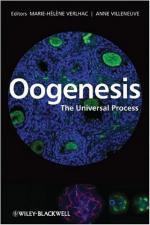|
This section contains 734 words (approx. 3 pages at 300 words per page) |

|
Oogenesis, or female gametogenesis, is the process by which diploid progenitor cells are reduced to haploid gametes in a female. This is a complicated pathway that begins in each female fetus and doesn't finish until the fertilization of the egg.
In early fetal development, the primordial germ cells migrate to the gonad. Mitotic divisions produce a population of oogonia with each oogonium in its own follicle. Development continues, and at about three months gestation, the oogonia have become primary oocytes. Shortly thereafter, the oocytes will randomly enter meiosis I but will proceed only to the dictyotene stage of prophase I where the cell division arrests. At the birth of a female infant, there will be approximately 2.5 x 106 primary oocytes that will remain in mid-meiosis I until they either degenerate, or ovulation occurs later in life.
At puberty, oogenesis begins again. Once a month from approximately twelve to fifty...
|
This section contains 734 words (approx. 3 pages at 300 words per page) |

|


